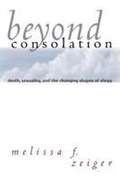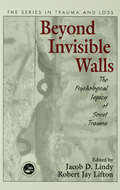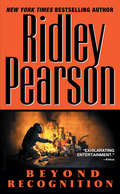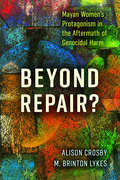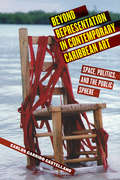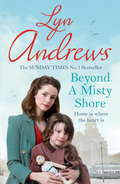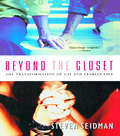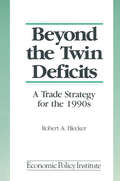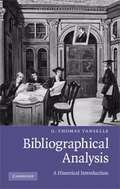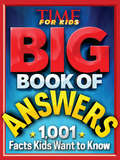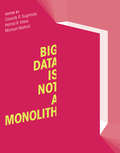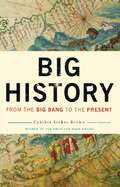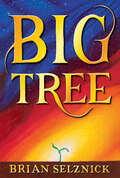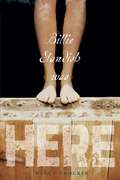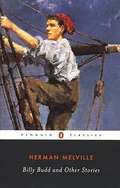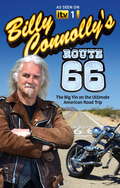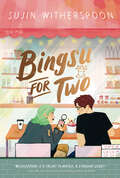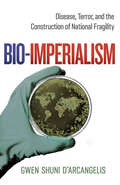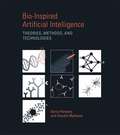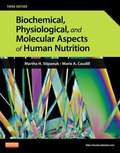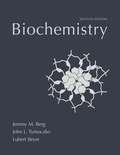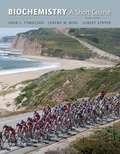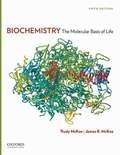- Table View
- List View
Beyond Consolation: Death, Sexuality, and the Changing Shapes of Elegy
by Melissa F. ZeigerUsing as her starting point the story of Orpheus and Eurydice, Melissa F. Zeiger examines modern transformations of poetic elegy, particularly as they reflect historical changes in the politics of gender and sexuality.
Beyond Invisible Walls: The Psychological Legacy of Soviet Trauma, East European Therapists and Their Patients (Series in Trauma and Loss)
by Robert Jay Lifton Jacob D. LindyWhen the Berlin Wall fell in 1989, Westerners watched those who had survived the era of Soviet trauma emerge into what we hoped would be the exhilarating light of freedom. What we have witnessed, however, is a slow and painful process of progression and regression, of hope and disillusionment, of unexpected psychological barriers: invisible walls that block the progress we had hoped for. In Beyond Invisible Walls, East European therapists, themselves, draw a compelling picture of the waves of trauma that their people endured, the institutions of trauma that remained well after Stalin's era, and their impact on survivors and their families. They describe the psychological remnants of those years: walls that confine people by unconsciously preserving old adaptations to political terror, walls that divide one part of the mind from another, and walls that rise between one generation and the next. These therapists' stories allow us a striking glimpse into how patients' trauma evokes the therapists' own wounds; how both speaker and empathic listener find their way to a healing process, how the two begin to dismantle these invisible walls.
Beyond Recognition
by Ridley PearsonSeattle police sergeant Lou Boldt is stunned when the local fire investigator presents him with frightening evidence in a series of fires that have occurred in the Seattle area. These white-hot fires burn so cleanly that even the ash disintegrates--leaving not a trace of its victims or any evidence of criminal activity. Only when Boldt is taunted by someone sending him pieces of melted green plastic--houses from a Monopoly board--does he realize that an arsonist is involving him in a deadly game.
Beyond Repair?: Mayan Women’s Protagonism in the Aftermath of Genocidal Harm (Genocide, Political Violence, Human Righ)
by M. Brinton Lykes Alison CrosbyBeyond Repair? explores Mayan women’s agency in the search for redress for harm suffered during the genocidal violence perpetrated by the Guatemalan state in the early 1980s at the height of the thirty-six-year armed conflict. The book draws on eight years of feminist participatory action research conducted with fifty-four Q’eqchi’, Kaqchikel, Chuj, and Mam women who are seeking truth, justice, and reparation for the violence they experienced during the war, and the women’s rights activists, lawyers, psychologists, Mayan rights activists, and researchers who have accompanied them as intermediaries for over a decade. Alison Crosby and M. Brinton Lykes use the concept of “protagonism” to deconstruct dominant psychological discursive constructions of women as “victims,” “survivors,” “selves,” “individuals,” and/or “subjects.” They argue that at different moments Mayan women have been actively engaged as protagonists in constructivist and discursive performances through which they have narrated new, mobile meanings of “Mayan woman,” repositioning themselves at the interstices of multiple communities and in their pursuit of redress for harm suffered.
Beyond Representation in Contemporary Caribbean Art: Space, Politics, and the Public Sphere (Critical Caribbean Studies)
by Carlos Garrido CastellanoThe Caribbean has been traditionally associated with externally devised mappings and categories, thus appearing as a passive entity to be consumed and categorized. Challenging these forces and representations, Carlos Garrido Castellano argues that something more must be added to the discussion in order to address contemporary Caribbean visual creativity. Beyond Representation in Contemporary Caribbean Art arises from several years of field research and curatorial activity in museums, universities, and cultural institutions of Jamaica, Trinidad, Martinique, Guadeloupe, Cuba, Dominican Republic, Puerto Rico, and the United States. This book explores the ways in which Caribbean individuals and communities have recurred to art and visual creativity to create and sustain public spaces of discussion and social interaction. The book analyzes contemporary Caribbean art in relation to broader discussions of citizenship, cultural agency, critical geography, migration, and social justice. Covering a broad range of artistic projects, including curatorial practice, socially engaged art, institutional politics, public art, and performance, this book is about the imaginative ways in which Caribbean subjects and communities rearrange the sociocultural framework(s) they inhabit and share.
Beyond Words: Movement Observation and Analysis
by Carol-Lynne Moore Kaoru YamamotoBeyond Words presents a range of illuminating approaches to examining every day social interactions, to help the reader understand human movement in new ways. Carol-Lynne Moore and Kaoru Yamamoto build on the principles that they expertly explored in the first edition of the book, maintaining a focus on the processes of movement as opposed to discussions of static body language. The authors combine textual discussion with a new set of website-hosted video instructions to ensure that readers develop an in-depth understanding of nonverbal communication, as well as the work of its most influential analyst, Rudolf Laban. This fully-revised, extensively illustrated second edition includes a new introduction by the authors. It presents a fascinating insight into this vital field of study, and will be an invaluable resource for scholars and practitioners in many activities, from performing and martial arts, athletics, to therapeutic and spiritual practices, conflict resolution, business interactions, and intercultural relations.
Beyond a Misty Shore: An utterly compelling saga of love and family
by Lyn AndrewsThe compelling novel from the Sunday Times bestselling author of TO LOVE AND TO CHERISHIt is 1945 and the war is finally over. For sisters Sophie and Maria, though, the upheaval is just beginning. For they have no choice but to leave their beloved home on the Isle of Man. It is a huge wrench for eighteen-year-old Maria, who can't forget Hans Bonhoeffer, a young Austrian, interned on the island during the war. For widowed Sophie, Liverpool offers a new beginning with her daughter Bella. She has no room for distractions - until she falls in love with Frank Ryan, a man married to a woman who, although she doesn't love him, has no intention of letting him go. Without the men they love, will the sisters ever find happiness?
Beyond the Black and White TV: Asian and Latin American Spectacle in Cold War America
by Benjamin M. HanThis is the first book that examines how “ethnic spectacle” in the form of Asian and Latin American bodies played a significant role in the cultural Cold War at three historic junctures: the Korean War in 1950, the Cuban Revolution in 1959, and the statehood of Hawaii in 1959. As a means to strengthen U.S. internationalism and in an effort to combat the growing influence of communism, television variety shows, such as The Xavier Cugat Show, The Ed Sullivan Show, and The Chevy Show, were envisioned as early forms of global television. Beyond the Black and White TV examines the intimate moments of cultural interactions between the white hosts and the ethnic guests to illustrate U.S. aspirations for global power through the medium of television. These depictions of racial harmony aimed to shape a new perception of the United States as an exemplary nation of democracy, equality, and globalism.
Beyond the Closet: The Transformation of Gay and Lesbian Life
by Steven SeidmanGay life has become increasingly open in the last decade. In Beyond the Closet , Steven Seidman, a well-known author and leading scholar in sexuality, is the first to chronicle this lifestyle change and to look at the lives of contemporary gays and lesbians to see how their "out" status has changed. This compelling, well-written, and smart account is an important step forward for the gay and lesbian community.
Beyond the Twin Deficits: A Trade Strategy for the 1990's (Economic Policy Institute Ser.)
by Robert A. BleckerThis study documents evidence of a decline trend in the international competitiveness of US industry. The analysis identifies three groups of countries that account for most of the US trade deficit in the 1980s: the surplus countries, Germany and Japan; the East Asian NICs; and the Latin American debtors. In each case the author points to underlying structural problems contributing to the deficit. They call for quite different US policy responses, including microeconomic and industrial policies, incentives to revive productivity, growth and technological innovation, import surcharges, wage increases in the NICs, currency realignments, US capital exports, and debt relief. A pragmatic policy approach, with efforts to open foreign markets, aims to achieve the greatest possible reduction in the trade deficit with the lowest possible cost from macroeconomic adjustments. The author urges the reversal of two adverse trends in his policy strategy: the decline in public sector investment and the decreasing progressivity of the tax code.
Bibliographical Analysis
by G. Thomas TanselleStudying printed books as physical objects can reveal not only how books were produced, but also how their design and layout features emerged and came to convey meanings. This concise and accessible introduction to analytical bibliography in its historical context explains in clear, non-specialist language how to find and analyze clues about a book's manufacture and how to examine the significance of a book's design. Written by one of the most eminent bibliographical and textual scholars working today, the book is both a practical guide to bibliographical research and a history of bibliography as a developing field of study. For all who use books, this is an ideal starting point for learning how to read the object along with the words.
Big Book of Answers: 1,001 Facts Kids Want to Know (Time For Kids Big Bks.)
by Editors of TIME For Kids MagazineIn a great new oversized format, TIME For Kids Big Book of Answers satisfies the most curious kids with answers to the questions they commonly ask but adults can rarely answer. Questions like ""How does popcorn pop?"", ""Where did the Titanic sink?"" and ""Why are our eyes different colors?"" are grouped into easy-to-navigate categories such as animals, humans, history, science and sports. Colorful photos, dynamic graphics, and simple text help kids discover 1,001 amazing facts to impress their parents, teachers, friends...and anyone else who will listen
Big Data Is Not a Monolith (Information Policy)
by Cassidy R. Sugimoto Hamid R. Ekbia Michael MattioliPerspectives on the varied challenges posed by big data for health, science, law, commerce, and politics.Big data is ubiquitous but heterogeneous. Big data can be used to tally clicks and traffic on web pages, find patterns in stock trades, track consumer preferences, identify linguistic correlations in large corpuses of texts. This book examines big data not as an undifferentiated whole but contextually, investigating the varied challenges posed by big data for health, science, law, commerce, and politics. Taken together, the chapters reveal a complex set of problems, practices, and policies.The advent of big data methodologies has challenged the theory-driven approach to scientific knowledge in favor of a data-driven one. Social media platforms and self-tracking tools change the way we see ourselves and others. The collection of data by corporations and government threatens privacy while promoting transparency. Meanwhile, politicians, policy makers, and ethicists are ill-prepared to deal with big data's ramifications. The contributors look at big data's effect on individuals as it exerts social control through monitoring, mining, and manipulation; big data and society, examining both its empowering and its constraining effects; big data and science, considering issues of data governance, provenance, reuse, and trust; and big data and organizations, discussing data responsibility, “data harm,” and decision making.ContributorsRyan Abbott, Cristina Alaimo, Kent R. Anderson, Mark Andrejevic, Diane E. Bailey, Mike Bailey, Mark Burdon, Fred H. Cate, Jorge L. Contreras, Simon DeDeo, Hamid R. Ekbia, Allison Goodwell, Jannis Kallinikos, Inna Kouper, M. Lynne Markus, Michael Mattioli, Paul Ohm, Scott Peppet, Beth Plale, Jason Portenoy, Julie Rennecker, Katie Shilton, Dan Sholler, Cassidy R. Sugimoto, Isuru Suriarachchi, Jevin D. West
Big History: From the Big Bang to the Present
by Cynthia Stokes BrownAn epic for our time, Big History begins when the universe is no more than a single point the size of an atom, squeezed together in unimaginable density, and ends with a twenty-first-century planet inhabited by 6.1 billion people. It's a story that takes in prehistoric geology, human evolution, the agrarian age, the Black Death, the voyages of Columbus, the industrial revolution, and global warming. Historian Cynthia Brown visits the Vikings, the Mayas and Aztecs, the Incas, the Mongol empire, and the Islamic heartlands. Along the way she considers topics as varied as cell formation, population growth, global disparities, and illiteracy, creating a stunning synthesis of historical and scientific knowledge of humanity and the earth we inhabit.Big History represents a new kind of history, one that skillfully interweaves historical knowledge and cutting-edge science. In an age of global warming, when the fate of the earth hangs in the balance, scientific advances permit us to see the universe as never before, grasping the timescales that allow us to understand the history of mankind in the context of its ecological impact on the planet. Cynthia Brown's lucid, accessible narrative is the first popularization of this innovative new field of study, as thrilling as it is ambitious.
Big Tree
by Brian SelznickThe fate of all life on Earth may depend on the bravery of two little seeds in this epic adventure from the #1 New York Times bestselling creator and Caldecott Medalist of The Invention of Hugo Cabret."The tale of the natural world is the greatest story we have to tell, and Brian delivers a brilliant chapter of that tale throughout the pages of Big Tree." - STEVEN SPIELBERG"We need brave, big stories like [Big Tree]." -The New York Times Book Review"Has the power to intrigue...affecting." - The Wall Street Journal* "An enthralling and expansive meditation on what it means to be alive on this planet." - Booklist, starred review* "A balanced and rich book. . . . Powerful."-The Bulletin of the Center for Children's Books, starred and recommended review* "In evocative prose and peppery dialogue . . . the cinematic story journeys across time and space, contemplating the power of life to heal." -Publishers Weekly, starred review* "A special, one-of-a-kind book for the whole family that readers won't soon forget." - School Library Journal, starred review* "Masterful." - The Horn Book, starred review"Inspirational, important, and beautiful. A fable for our times." - Alan Gratz, bestselling author of Refugee and Ground Zero"Hello, stars. I thought I heard you calling me."A mysterious voice has been speaking to Louise in her dreams. She and her brother Merwin are Sycamore seeds, who hope to one day set down roots and become big trees. But when a fire forces them to leave their mama tree prematurely, they find themselves catapulted into the unknown, far from home. Alone and unprepared, they must use their wits and imagination to navigate a dangerous world-filled with dinosaurs, meteors, and volcanoes!-and the fear of never finding a safe place to grow up. As the mysterious voice gets louder, Louise comes to realize their mission in life may be much bigger than either of them ever could have imagined!Brimming with humor, wonder, mystery, and a profound sense of hope, Big Tree is a trailblazing adventure, illustrated with nearly 300 pages of breathtaking pictures. It is Selznick's most imaginative and far-reaching work to date and a singular reading experience for the whole family.The audiobook edition of BIG TREE is brought magnificently to life by Meryl Streep and features music composed by Ernest Troost.
Billie Standish Was Here
by Nancy CrockerCAN ONE UNLIKELY FRIENDSHIP SAVE A LIFE? Billie Standish has pretty much no one. Her parents are too caught up in their own lives, and the only two girls in town her age want nothing to do with her. When it looks like a nearby levee might break, and Billie's elderly neighbor, Miss Lydia, is the only other person besides her family to stick around, a friendship is born out of circumstance. What happens during that time, in that empty town, is a tragedy that Billie can't bear alone. Can the love of one woman nearing the end of her life save the life of a young woman just at the beginning of living hers?
Billy Budd and Other Stories
by Herman Melville Frederick Busch"Billy Budd, Sailor," a classic confrontation between good and evil, is the story of an innocent young man unable to defend himself from wrongful accusations. Other selections include "Bartleby," "The Piazza," "The Encantadas," "The Bell-Tower," "Benito Cereno," "The Paradise of Bachelors," and "The Tartarus of Maids."
Billy Connolly's Route 66: The Big Yin on the Ultimate American Road Trip
by Billy ConnollyBritain's best-loved comedian hits the most famous highway in the world on an unforgettable journey.Billy Connolly, music-lover, biker, and scourge of the beige and bland the world over, has dreamed about taking a trip on the legendary Route 66 since he heard Chuck Berry belting out one of the greatest rock 'n' roll records of all time. And now he's finally had the chance to do it, travelling every mile on his custom-made trike in search of the real America that can still be found beyond the nation's freeways.Taking in both the essential icons and the hidden gems of the 'Mother Road', Billy also meets up with plenty of the memorable characters who call it home. With his instinct for a good story, and the infectious enthusiasm that has made him our most engaging national treasures, Billy Connolly is the ultimate guide to the ultimate road trip.
Bingsu for Two
by Sujin WitherspoonThis outrageously charming and infuriatingly adorable enemies-to-lovers coffee shop romance is perfect for fans of YA books by Jenny Han and Better Than the Movies. Meet River Langston-Lee. In the past 24 hours, he&’s dumped his girlfriend, walked out of his SATs, and quit his job at his parents&’ cafe in spectacularly disastrous fashion—even for him. Somehow, he manages to talk his way into a gig at a failing Korean cafe, Bingsu for Two, which is his lucky break until he meets short, grumpy, and goth: Sarang Cho. She&’s his new no-BS co-worker who&’s as determined to make River&’s life hell as she is to save her family&’s cafe. After River accidentally uploads a video of his chaotic co-workers to his popular fandom account, they strike viral fame. The kicker? Their new fans ship River and Sarang big-time. In order to keep the Internet&’s attention—and the cafe&’s new paying customers—River and Sarang must pretend that the tension between them is definitely of the romantic variety, not the considering the best way to kill you and hide your body variety. But when Bingsu for Two&’s newfound success catches the attention of River&’s ex and his parents&’ cafe around the corner, he faces a choice: keep letting others control his life or stand up for the place that&’s become home. And a green-haired girl who&’s not as heartless as he originally thought . . . Bingsu for Two delivers a swoon-worthy romance that'll make you crave a Korean cafe adventure of your own. Fans of young adult romance books and books for teen girls will love this addictive debut that dishes up a serving of humor, heart, and hope.
Bio-Imperialism: Disease, Terror, and the Construction of National Fragility
by Gwen Shuni D'ArcangelisBio-Imperialism focuses on an understudied dimension of the war on terror: the fight against bioterrorism. This component of the war enlisted the biosciences and public health fields to build up the U.S. biodefense industry and U.S. global disease control. The book argues that U.S. imperial ambitions drove these shifts in focus, aided by gendered and racialized discourses on terrorism, disease, and science. These narratives helped rationalize American research expansion into dangerous germs and bioweapons in the name of biodefense and bolstered the U.S. rationale for increased interference in the disease control decisions of Global South nations. Bio-Imperialism is a sobering look at how the war on terror impacted the world in ways that we are only just starting to grapple with.
Bio-Inspired Artificial Intelligence: Theories, Methods, and Technologies
by Dario Floreano Claudio MattiussiNew approaches to artificial intelligence spring from the idea that intelligence emerges as much from cells, bodies, and societies as it does from evolution, development, and learning. Traditionally, artificial intelligence has been concerned with reproducing the abilities of human brains; newer approaches take inspiration from a wider range of biological structures that that are capable of autonomous self-organization. Examples of these new approaches include evolutionary computation and evolutionary electronics, artificial neural networks, immune systems, biorobotics, and swarm intelligence--to mention only a few. This book offers a comprehensive introduction to the emerging field of biologically inspired artificial intelligence that can be used as an upper-level text or as a reference for researchers. Each chapter presents computational approaches inspired by a different biological system; each begins with background information about the biological system and then proceeds to develop computational models that make use of biological concepts. The chapters cover evolutionary computation and electronics; cellular systems; neural systems, including neuromorphic engineering; developmental systems; immune systems; behavioral systems--including several approaches to robotics, including behavior-based, bio-mimetic, epigenetic, and evolutionary robots; and collective systems, including swarm robotics as well as cooperative and competitive co-evolving systems. Chapters end with a concluding overview and suggested reading.
Biochemical, Physiological, And Molecular Aspects of Human Nutrition
by Martha H. Stipanuk Marie A. CaudillCovering advanced nutrition with a comprehensive, easy-to-understand approach, Biochemical, Physiological, and Molecular Aspects of Human Nutrition, 3rd Edition focuses on the biology of human nutrition at the molecular, cellular, tissue, and whole-body levels. It addresses nutrients by classification, and describes macronutrient function from digestion to metabolism. This edition includes the new MyPlate dietary guide and recommendations from the Dietary Guidelines for Americans 2010, plus coverage of the historical evolution of nutrition and information on a wide range of vitamins, minerals, and other food components. In Biochemical, Physiological, and Molecular Aspects of Human Nutrition, lead authors Martha H. Stipanuk and Marie A. Caudill are joined by a team of nutrition experts in providing clear, concise, coverage of advanced nutrition.
Biochemistry Seventh Edition
by John L. Tymoczko Jeremy M. Berg Lubert StryerSince its first edition in 1975, this extraordinary textbook has helped shape the way biochemistry is taught, offering exceptionally clear writing, innovative graphics, coverage of the latest research techniques and advances, and a signature emphasis on physiological and medical relevance. Those defining features are at the heart of the new Seventh Edition of Biochemistry, which again communicates fundamental concepts and the latest breakthroughs in a way that makes the information engaging and understandable for students approaching the subject for the first time.
Biochemistry: A Short Course (Second Edition)
by John L. Tymoczko Jeremy M. Berg Lubert StryerThis book covers the fundamentals of biochemistry and its topics are broadly grouped under three parts : Molecular design of life,Transducing and storing energy and Synthesizing the molecules of life.
Biochemistry: The Molecular Basis of Life
by James R. Mckee Trudy MckeeBiochemistry: The Molecular Basis of Life is an intermediate, one-semester text written for students on degree pathways in Chemistry, Biology and other Health and Life Sciences. Aimed at students with one unit of Organic Chemistry, it focuses on essential biochemical principles that underpin the modern life sciences, and offers a balanced coverage of chemistry and biology.
